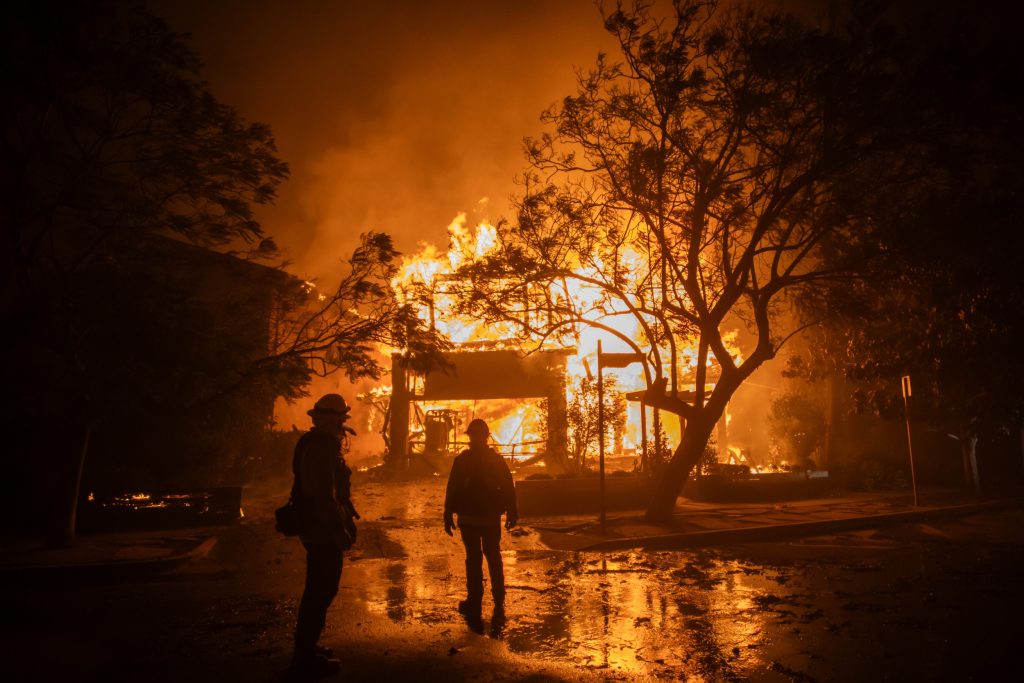The raging wildfires tearing through Southern California paint a grim picture of devastation and displacement, with thousands of acres scorched and tens of thousands of residents forced to flee their homes. Fueled by powerful winds, the Palisades fire, the largest of the current blazes, erupted in Los Angeles County on Tuesday, rapidly consuming the affluent Pacific Palisades neighborhood and spreading throughout the region. The speed and intensity of the fire forced Santa Monica officials to issue evacuation orders, underscoring the immediate threat to life and property. Adding to the crisis, the Eaton fire ignited near Pasadena in Eaton Canyon, further stretching firefighting resources and expanding the area under threat. The ferocity of these fires, captured in chilling videos shared on social media, showcases the harrowing reality faced by residents who were forced to abandon their homes with little more than the clothes on their backs.
The video shared by Tanner Charles, an online content creator and storm chaser, offers a visceral glimpse into the chaos and fear experienced by those caught in the fire’s path. The footage depicts Charles and a friend fleeing a burning home, the air thick with smoke and ash, flames engulfing the surrounding landscape. Their desperate escape, punctuated by expressions of disbelief and sorrow, underscores the personal tragedies unfolding amidst the wider disaster. The devastation witnessed by Charles and his friend is sadly not an isolated incident, as the rapidly spreading fires threatened countless homes and businesses. Officials have warned of significant property losses, with early estimates suggesting widespread destruction across the affected areas. California Governor Gavin Newsom confirmed the destruction of “many structures,” highlighting the scale of the damage, the full extent of which will take time to assess.
The current wildfires underscore California’s vulnerability to such events, a vulnerability exacerbated by the impacts of climate change. Scientists have long warned that global warming is intensifying wildfire seasons, making them more frequent, more intense, and more destructive. California, with its dry, hot summers and increasingly prevalent drought conditions, provides the perfect tinderbox for these climate-fueled infernos. The 2024 fire season, even before the current outbreaks, had already witnessed over 8,000 wildfires consuming over a million acres across the state, a stark reminder of the escalating threat. These fires not only destroy homes and livelihoods but also pose significant risks to human health and the environment, releasing vast amounts of smoke and particulate matter into the atmosphere.
The fight against the current blazes continues, hampered by fierce winds that are fanning the flames and challenging firefighting efforts. Wind gusts of up to 60 mph are predicted to persist through Thursday, creating volatile conditions that could further accelerate the fires’ spread and complicate containment efforts. Firefighters are battling tirelessly to protect lives and property, but the strong winds pose a significant obstacle. The combination of extreme heat, dry vegetation, and powerful winds creates a recipe for rapid fire growth and unpredictable fire behavior, making the task of containing the blazes exceptionally difficult.
The devastation wrought by these wildfires extends beyond the immediate loss of homes and property. The emotional toll on those forced to evacuate, the disruption to communities, and the long-term impacts on the environment are all significant concerns. The loss of homes, cherished possessions, and a sense of security can have lasting psychological effects on individuals and families. The disruption to businesses, schools, and essential services further compounds the challenges faced by affected communities. Moreover, the ecological damage caused by these fires, including habitat loss, soil erosion, and air pollution, can take years to recover from.
Looking ahead, the immediate focus remains on containing the fires and ensuring the safety of residents. The ongoing windstorm presents a major challenge, but firefighters are working tirelessly to suppress the flames and protect communities. Beyond the immediate crisis, the need for long-term strategies to address the growing wildfire threat is paramount. This includes investing in fire prevention measures, improving forest management practices, and addressing the underlying causes of climate change. Building resilient communities that can withstand and recover from these increasingly frequent and intense wildfires will require a comprehensive and sustained effort from individuals, communities, and governments alike. The current fires serve as a stark reminder of the urgent need for action to mitigate the risks and protect California’s vulnerable landscapes and communities.










